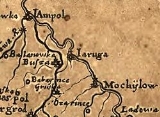
Busha
Encyclopedia
Busha is a village in Yampilskyi Raion, Vinnytsia Oblast
, Ukraine
. It got the status of a city in the early 17th century. In 1629 there were 2.000 people living in this city.
, Chernyakhov culture
, and Old East Slavic cultures.
Busha is known in history because of the Peace of Busza
that was signed in this village between the Polish-Lithuanian Commonwealth
and the Ottoman Empire
on September 23, 1617. During the mid-17th century, the city, situated in Bracław Voivodeship of the Polish-Lithuanian Commonwealth
, was also the site of several battles between Poles and Ukrainian Cossacks.
After the destruction of the fortress in November 1654 the city soon lost its status and was degraded to village. The village has several historical monuments such as the ruins after the 15-16th century fortress and a town hall.
Vinnytsia Oblast
Vinnytsia Oblast is an oblast of Ukraine. Its administrative center is Vinnytsia.-Geography:The area of the region is 26,500 km²; its population is 1.7 million....
, Ukraine
Ukraine
Ukraine is a country in Eastern Europe. It has an area of 603,628 km², making it the second largest contiguous country on the European continent, after Russia...
. It got the status of a city in the early 17th century. In 1629 there were 2.000 people living in this city.
History
Historical settlements in the area date back to several ancient civilizations, including Cucuteni-Trypillian culture, ScythiaScythia
In antiquity, Scythian or Scyths were terms used by the Greeks to refer to certain Iranian groups of horse-riding nomadic pastoralists who dwelt on the Pontic-Caspian steppe...
, Chernyakhov culture
Chernyakhov culture
The Sântana de Mureș–Chernyakhiv culture is the name given to an archaeological culture which flourished between the 2nd and 5th centuries in a wide area of Eastern Europe, specifically in what today constitutes Ukraine, Romania, Moldova, and parts of Belarus...
, and Old East Slavic cultures.
Busha is known in history because of the Peace of Busza
Peace of Busza
The Peace of Busza also known as the Treaty of Jaruga was negotiated by Stanisław Żółkiewski of the Polish-Lithuanian Commonwealth and Iskender Pasha of the Ottoman Empire in Busza near the Jaruga and Dniester rivers on September 23, 1617. Polish and Ottoman armies met, but decided to negotiate,...
that was signed in this village between the Polish-Lithuanian Commonwealth
Polish-Lithuanian Commonwealth
The Polish–Lithuanian Commonwealth was a dualistic state of Poland and Lithuania ruled by a common monarch. It was the largest and one of the most populous countries of 16th- and 17th‑century Europe with some and a multi-ethnic population of 11 million at its peak in the early 17th century...
and the Ottoman Empire
Ottoman Empire
The Ottoman EmpireIt was usually referred to as the "Ottoman Empire", the "Turkish Empire", the "Ottoman Caliphate" or more commonly "Turkey" by its contemporaries...
on September 23, 1617. During the mid-17th century, the city, situated in Bracław Voivodeship of the Polish-Lithuanian Commonwealth
Polish-Lithuanian Commonwealth
The Polish–Lithuanian Commonwealth was a dualistic state of Poland and Lithuania ruled by a common monarch. It was the largest and one of the most populous countries of 16th- and 17th‑century Europe with some and a multi-ethnic population of 11 million at its peak in the early 17th century...
, was also the site of several battles between Poles and Ukrainian Cossacks.
After the destruction of the fortress in November 1654 the city soon lost its status and was degraded to village. The village has several historical monuments such as the ruins after the 15-16th century fortress and a town hall.

